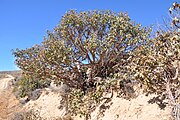Cistus laurifolius
| Cistus laurifolius | |
|---|---|
 | |
| Scientific classification | |
| Kingdom: | Plantae |
| (unranked): | Angiosperms |
| (unranked): | Eudicots |
| (unranked): | Rosids |
| Order: | Malvales |
| Family: | Cistaceae |
| Genus: | Cistus |
| Species: | C. laurifolius |
| Binomial name | |
| Cistus laurifolius L. | |
Cistus laurifolius, commonly called laurel-leaf cistus[1] or laurel-leaved rock rose, is a species of highly branched flowering evergreen shrub native to some areas around the Mediterranean. It grows 0.8–2 m (2 ft 7 in–6 ft 7 in) high. The branches are strong and erect, with reddish bark that is easily removed in strips. The leaves are larger than in the other species of Cistus, up to 9 cm (4 in) long, lanceolate, dark green, while the underside is whitish due to trichomes. It bears white flowers with a yellow spot in each petal, of 4.5–5 cm diameter,[2] in late spring. It is widely cultivated in gardens, and has gained the Royal Horticultural Society's Award of Garden Merit.[3]
Distribution and habitat
Cistus laurifolius has a disjunct natural distribution, in the Western Mediterranean area (Morocco, Portugal, Spain, southern France, Corsica and Tuscany), the Aegean and Anatolia.[2]
With the general warming of the atmosphere and the consequent withdrawal of the ice, flora surviving from Tertiary times could not re-establish their range in southern Europe; the new post-glacial climate was drier than that of the Tertiary. The original tropical European flora evolved into the present Mediterranean sclerophyll flora.[4][5][6] The distribution of some surviving species, such as Cistus laurifolius, moved to wetter areas such as the mountains.[6] Due to this, C. laurifolius is named in Spanish in its distribution area as "mountain rockrose",[6] although in the coastal west and northwest Iberian Peninsula, it is found at sea level.[7]
Cistus shrubland, including C. laurifolius, survives fire and has seeds that germinate after fire.[8]
-
A bush of Cistus laurifolius
-
-

-
Subtaxa
- Cistus laurifolius var. atlanticus Pit.[9]
- Cistus laurifolius var. lanceolatus Rouy & Foucaud
- Cistus laurifolius var. laurifolius
- Cistus laurifolius var. ovatus Rouy & Foucaud
References
- ↑ "USDA GRIN Taxonomy".
- ↑ 2.0 2.1 Flora Iberica 3: 331
- ↑ http://apps.rhs.org.uk/plantselector/plant?plantid=430
- ↑ John W. Harshberger (1926). "Mediterranean Garigue and Macchia (first page)". Proceedings of the American Philosophical Society 65 (1): 56–63.
- ↑ Fernández-Mazuecos, M.; Vargas, P. (2010). "Ecological rather than geographical isolation dominates Quaternary formation of Mediterranean Cistus species". Molecular Ecology 19 (7): 1381–1395. doi:10.1111/j.1365-294x.2010.04549.x.
- ↑ 6.0 6.1 6.2 Beatriz Guzmán, Pablo Vargas (2005). "Systematics, character evolution, and biogeography of Cistus L. (Cistaceae) based on ITS, trnL-trnF, and matK sequences". Molecular Phylogenetics and Evolution 37: 644–660. doi:10.1016/j.ympev.2005.04.026.
- ↑ Antonio Rigueiro Rodríguez, and Fco. Javier Silva-Pando. "Aportaciones A La Flora De Galicia, I.". Anales Jard. Bot. Madrid 40 (2): 385–395.
- ↑ R. Tárrega, E. Luis-Calabuig & I. Alonso (1997). "Space-time heterogeneity in the recovery after experimental burning and cutting in a Cistus laurifolius shrubland". Plant Ecology 129: 179–187.
- ↑ "Tropicos.org".
External links
| Wikimedia Commons has media related to Cistus laurifolius. |
| Wikispecies has information related to: Cistus laurifolius |


